Geochronological and geochemical constraints on the granitic gneiss in the Huozhou Complex: implications for the tectonic evolution of the Trans-North China Orogen
2023-03-09ChongPengHaiyanLiuRuiyingZhangCremildaSamuelJofrisseLinfuXueBaozhiPan
Chong Peng · Haiyan Liu · Ruiying Zhang · Cremilda Samuel Jofrisse ·Linfu Xue · Baozhi Pan
Abstract The Trans-North China Orogen is a major Neoarchean Paleoproterozoic collisional orogenic belt above the North China Craton,formed due to prolonged and complex processes.Even though many Neoarchean-Paleoproterozoic magmatic and metamorphic activities have been reported,due to the Huozhou Complex’s small outcropping range,little attention has been paid to the origin of various igneous rocks of the Huozhou Complex in the center of the Trans-North China Orogen.The Huozhou Complex,located south of the Lüliang,Wutai,and Hengshan complexes,is an important window into the Early Precambrian structure and evolution of the North China Craton.Its magma and metamorphism are crucial to understanding the development of the structural evolution of the Trans-North China Orogen.The Huozhou metamorphic complex area exposes a range of Precambrian metamorphic rocks,among which the most extensively dispersed is felsic biotite plagioclase gneiss.In this study comprehensive geological field survey,micropetrology,chronology,geochemistry,and Hf isotope analysis were carried out for the Qinggangping and Anziping gneiss in the north of the Huozhou Complex.The results show that the magmatic zircon age of the Qinggangping gneiss is 2196 ± 14 Ma,and its protolith is I-type granite,formed by partial melting of igneous rocks in the absence of weathering.Its source is mainly the juvenile crust from depleted mantle dating 2431-2719 Ma,with a small amount of mantle-derived material.The Anziping gneiss has a metamorphic zircon age of 1931 ± 13 Ma with an S-type granite protolith belonging to peraluminous granite.The Anziping gneiss is formed by recycling pre-existing crustal components at 2613-2848 Ma.A minor quantity of mantle-derived magma is also introduced to the crust simultaneously.The samples of Qinggangping gneiss and Anziping gneiss show the characteristics of obvious negative Nb,Ti,and P elements in the spider diagram of primitive mantle standardization.This implies that the rocks have the characteristics of magmatic rocks in an island arc or subduction environment,which could have formed in the tectonic environment of the continental margin arc.
Keywords Zircon U-Pb dating·Geochemistry·Huozhou complex · Trans-North China orogen · Biotite plagioclase gneiss · North China craton
1 Introduction
The North China Craton (NCC) is China’s oldest and largest continental block,with more than 3800 Ma evolutionary history (Liu et al.1992,2007;Song et al.1996).It has gone through a complex multistage tectonic evolution and is a major focus of Precambrian geological research(Peng et al.2020,2021;Wan et al.2005).Scholars agree that the NCC is divided into three sections: the Eastern Block,the Western Block,and the TNCO (TNCO;Fig.1;Zhao et al.2005).Despite the widespread acceptance of this division scheme,there were still differing interpretations of the subduction polarity between the eastern and western continental blocks and the splicing age of the continental blocks.There are three different models: (1)Since the late Archean,a long-lived Andean-type continental arc has existed on the western margin of the Eastern Block,which is primarily supported by the presence of massive 2.56-1.95 Ga arc-like granitoids,volcanics,and sedimentary rocks along the orogen (Zhao et al.2001,Zhao et al.2002a,Zhao et al.2005,Zhao et al.2008a,Liu et al.2012a,Liu et al.2012b,Liu et al.2014a,b,Su et al.2014,Yang and Santosh 2015).(2)The NCC went through continental rifting and oceanic subduction before 1.95 Ga because volcanic rocks in this orogen exhibit both bimodal and arc-type geochemical characteristics (Geng et al.2006;Zhai and Peng 2007;Du et al.2013;Zhai 2019).(3)The NCC has been classified by some scholars into three continental blocks and two suture zones.The Eastern Block and Fuping Block collided at 2.1 Ga in the Taihang suture zone and subsequently collided with the Western Block at 1.9-1.8 Ga to form the TNCO assuming the subduction direction of the two collisions as east to West(Faure et al.2007;Trap et al.2009).
The tectonic evolution of the Precambrian basement of the NCC was more complex than the division model described above.To comprehend its long-term evolution process,a more detailed and multifaceted investigation is required.The Huozhou metamorphic complex is located in the central region of the TNCO (Fig.1,2),and it has significant research value in understanding the tectonic evolution of the TNCO.However,the origin of various igneous rocks in the Huozhou Complex in the southern TNCO has received little attention.Because their emplacement ages,metamorphism ages,petrogenesis,and relationship to regional magmatism are unknown,we have limited understanding of the TNCO’s tectonic evolution in relation to the NCC’s continental convergence between the Eastern and Western Blocks.Early regional geological surveys classified the metamorphic rocks in the Archean complex as Archean strata,which are further classified as the Archean Upper group and the Huoxianzhou Lower group(SBGMR,1989).These formations are dominated by felsic to moderate gneiss with minor quartzite,amphibolite,schist,and hybrid rocks and are typically metamorphosed by the amphibolite-granulite facies (SBGMR,1989).However,a growing number of field mapping and geochronological studies have revealed that these Archean metamorphic strata are,in fact,primarily proterozoic plutonic rocks (Diwu et al.2014;Zhao et al.2018;Liu et al.2021;Wang et al.2020,2021,2022a,b;Zhou et al.2021).Although Paleoproterozoic magmatic rocks have been found in the Huozhou area,the types,metamorphism,and tectonic setting of these Paleoproterozoic magmatic rocks need further exploration(Wang et al.2022a,b).Moreover,a comprehensive analysis of the Paleoproterozoic magmatic and metamorphic events of the Huozhou Complex,tracing its source characteristics,discussing its magmatic and metamorphic age,and tectonic environment,can provide substantial evidence for the Paleoproterozoic geological evolution of the NCC.It is also essential for exploring the early geological evolution of the NCC and even the global craton.
2 Geological background
The TNCO of the NCC extends in a north-south direction for 1200 km (Fig.1;Zhao et al.2005;Zhao et al.2008a,b).There are numerous Meso-Neoarchean and Paleoproterozoic granitoids and metamorphic volcanic sedimentary rocks exposed from south to north in Dengfeng,Zhongtiao,Lüliang,Wutai,and Huai’an (Diwu et al.2014;Jiang et al.2011;Kröner et al.2005;Li et al.2015a;Qian et al.2013,2015;Wang et al.2014;Zhao et al.2002,2005,2008a,b,2010).
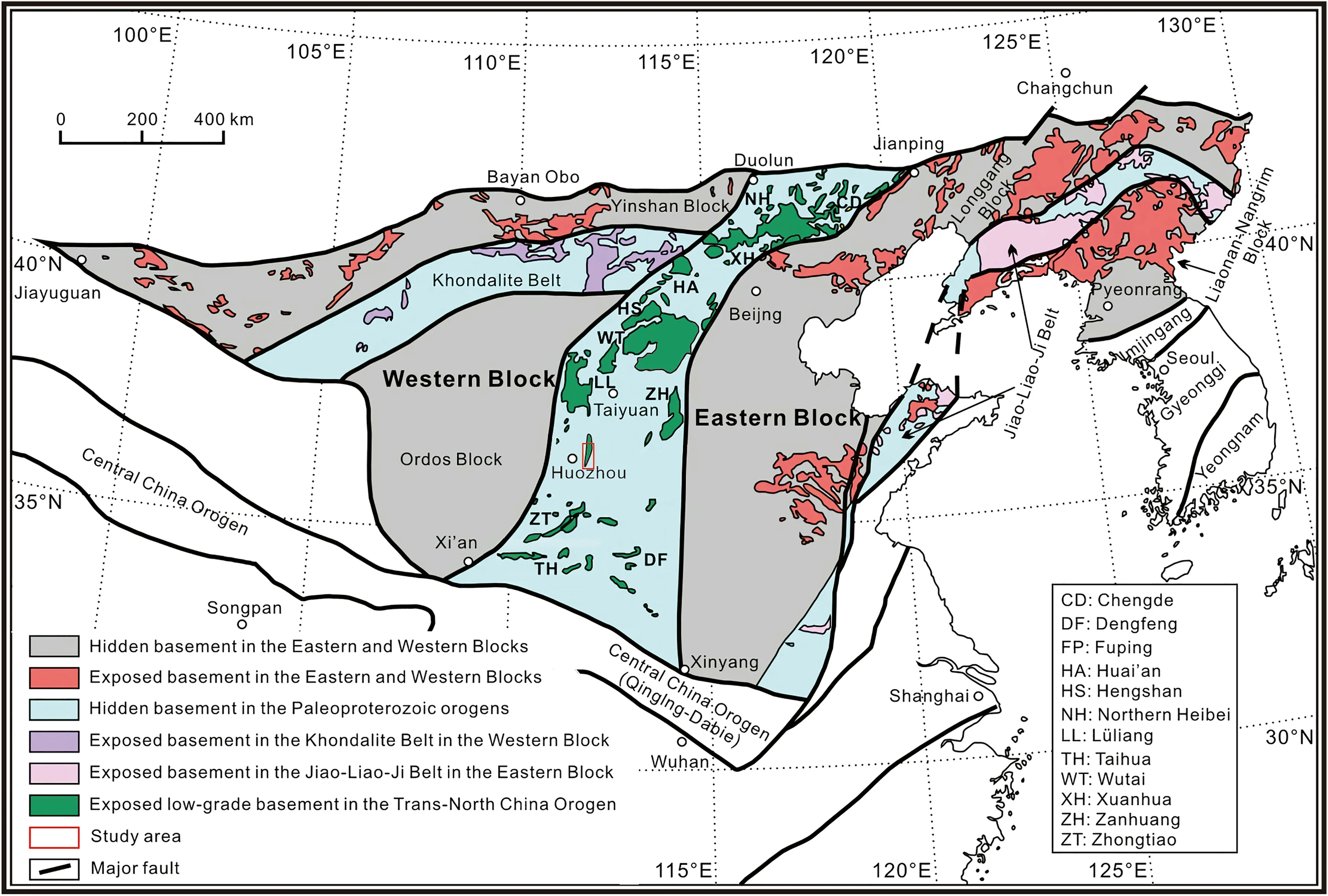
Fig.1 Tectonic subdivision of the NCC (Wang et al.2022a,b;Xu and Liu 2019;Zhao et al.2012)
In reality,limited studies have been done on the complex in the eastern part of Huozhou,without a firm conclusion on its formation age.To facilitate further classification and discussion,we collectively denote the area located in the east of Huozhou in the Taiyue mountains as Huozhou Complex (Fig.2).The main body of the complex,distributed in a north-south direction,is mainly dominated by gneiss.The Paleoproterozoic granites of Majiagou,Qinggangping,Zhengnangou,Dananping,and Anziping,extending over 60 km,are the most developed sites in the central zone.According to earlier studies,the rocks in this area were thought to have developed during the Neoarchean period (SBGMR 1989).The Taiyue Mountain and Huoxian Groups were designated by a Shanxi regional survey team and a 213 geological team in 1973.
Recently,a 15 km east-west section in the Huozhou area(Figs.2 and 3)was reported;the rocks exposed in the section are primarily gneiss high potassium granite,horndiorite gneiss,and diorite,with no sedimentary rocks found(Wang et al.2022a,b).In high potassium granites,horndiorite gneiss,and diorite,the intrusive contact relationship is not obvious.Both appear to have occurred in the wild at the same time,both invaded by late mafic dikes and massive granites (Wang et al.2022a,b).The granite,horndiorite gneiss,and diorite outcrops in the study area are strongly deformed and discontinuous,with no relationship to the sedimentary sequence discovered.
The Huozhou Complex is overlined by Cambrian strata,and all faults belonging to the Taiyueshan fault are extensively developed in the distribution area of the Huozhou Complex.Since the Mesozoic,the fault has been active for many periods,resulting in very complex structural characteristics.
3 Sample collection and petrographic characteristics
The sample HQ01 of Qinggangping gneiss was collected in the area to the north after a detailed field geological exploration of the study area.The geographical coordinates of the sample location are 36°40′29′′N and 111°54′42′′E.The sample location falls within the Neoarchean distribution range of the Jingou Formation of the Taiyueshan Group,according to the regional geological unit division system of Shanxi Province(Fig.2).The primary rock type in the area is biotite plagioclase gneiss,which is light flesh red to gray,medium to coarse-grained,with a granitic crystalloblastic and gneissic structure.The original rock is an acid plutonic intrusion,as indicated by the field occurrence and form of rock stock rather than the strata.The following are the petrographic characteristics of the sample(Fig.4): The rock sample is gray,with plagioclase and biotite as the primary minerals,and a columnar granular crystalloblastic and gneissic structure.Plagioclase (30%and 35%)has particle sizes varying from 0.30 to 0.75 mm,whereas biotite (10% and 15%) has particle sizes varying from 0.12 to 0.70 mm,with yellowish-brown color,exhibiting polychromism and flaky nature.A group of cleavages is well developed in biotite,with secondary chloritization and iron precipitation.Along the cleavage fracture,iron is entirely replaced by chlorite,resulting in a false image structure.Potassium feldspar (20% and 25%)has a particle size of approximately 0.15 to 0.85 mm,mainly forming striped feldspar,microcline,etc.,and is semi-idiomorphic,wide plate-shaped,and granular,while quartz (20% and 25%) has a particle size of about 0.05 to 3.20 mm.

Fig.2 Geological map of the Huozhou metamorphic complex generated from 1:200,000 Geological map of China,Linfen sheet.The numerals 1 represent the Jiehekou group,the numerals 2 to 3 represent the Pengpenggou formation,and the Xiaonanping formation which both belong to the Huoxian Group,the numerals 4 represent the Anziping gneiss,the numerals 5 to 6 represent the Anziping formation and Huangliang formation which both belong the Huoxian Group,the numerals 7 represent the Qinggangping gneissJingou formation of the Taiyueshan Group,the numerals 8-11 represent the diabase dyke,the fault,the sampling location,and the measured cross-section location,in that order

Fig.3 Measured cross-section showing diorites,granites,and mafic-ultramafic cumulates in the Huozhou Complex (Wang et al.2022a,b)
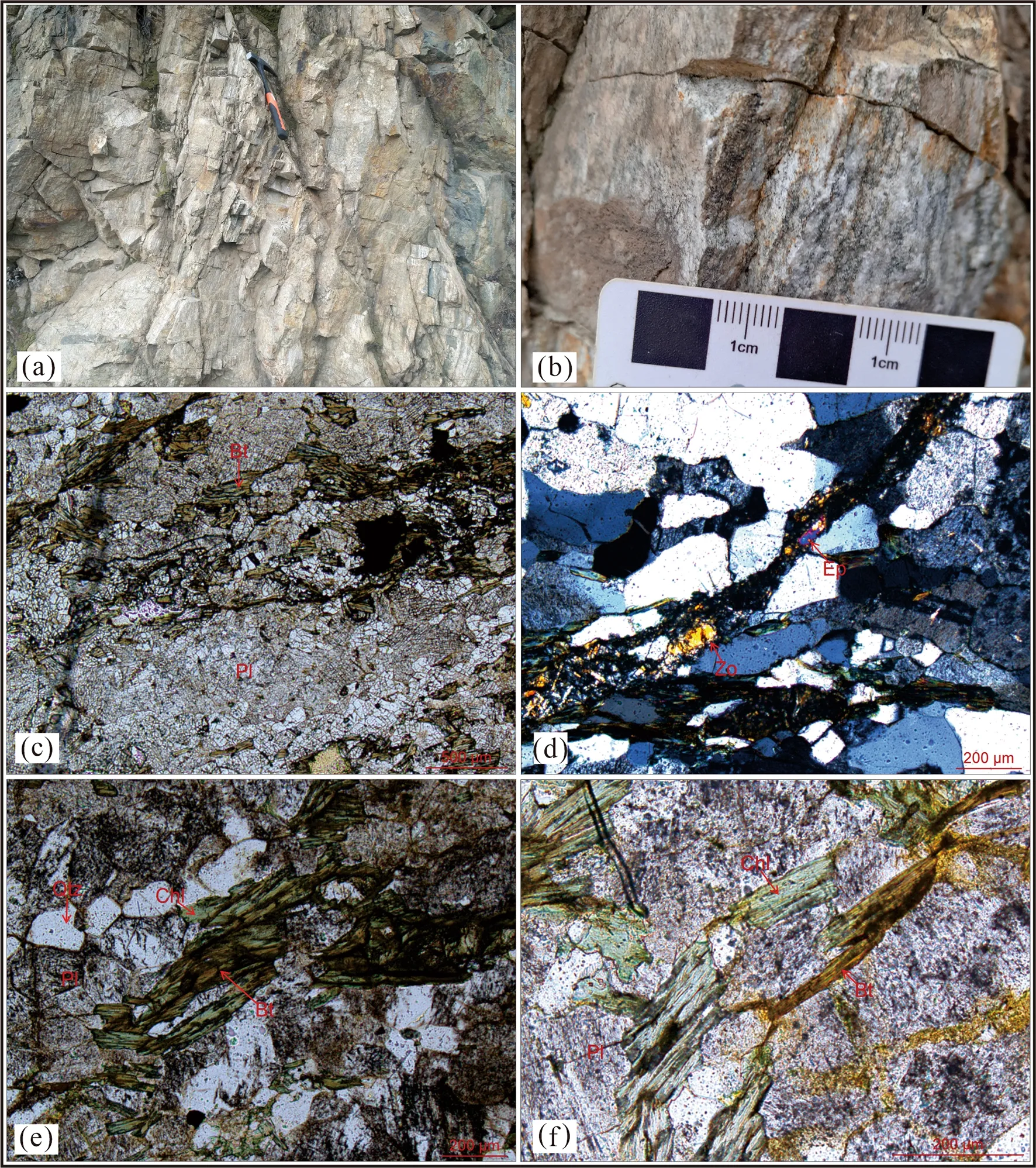
Fig.4 The photo of the outcrop and the micrograph of Qinggangping gneiss(sample HQ01).(a)Sampling location of sample HQ01;(b)Gneiss outcrop showing weak gneiss;(c)Monopolar micrograph of gneiss,epidote veinlets;(d)Micrograph of biotite gneiss,orthogonal polarization in micrograph;(e) Chloritization of biotite and (f) Chloritization of biotite.Mineral abbreviations: Qtz,Pl,Bt,Grt,and Chl,represent quartz plagioclase,biotite,garnet,and chlorite
Simultaneously,we collected sample HX01 from the Anziping gneiss in the southern portion of the study area.The coordinates of the sample location are 36°21′55′′N and 111°49′15′′E (Fig.2).The sample is located in the distribution range of the Dananping Formation of the Huoxian Group in the Neoarchean era (Fig.2) according to the division method of geological units in the regional geological records of Shanxi Province.The dominant rock type in this area is also biotite plagioclase gneiss,which is light gray exhibiting granitic,crystalloblastic,and gneissic structures.The form of field occurrence is the same as HQ01,indicating that its original rock is an acid plutonic intrusion.Petrographic identification of the HX01 sample(Fig.5) indicates lepido granoblastic texture and gneissic structures,and the main minerals are plagioclase,quartz,biotite,amphibole,and garnet.Plagioclase(50%and 55%)is characterized by 0.15-2.30 mm particle size,semi-idiomorphic,plate-shaped,and lenticular,with bicrystal flake,strong secondary sericitization,sodium tetrahedrite,and carbonation as carbonate bands could be seen,and a roughly oriented long axis.Similarly,quartz (10% and 15%)is characterized by about 0.05-0.56 mm particle size,allomorphic granular and relatively broken,with lightcolored strip aggregates.Biotite (25% and 30%) had a particle size of approximately 0.10-0.80 mm with reddishbrown or yellowish-brown flakes,while a group of cleavages developed strongly with some secondary chloritization,with massive or banded local aggregates,arranged intermittently and directionally,forming a gneissic structure.The amphibole (1% and 3%) had a particle size of about 0.15-0.60 mm,with grayish-green or yellowishgreen color,semi-idiomorphic columnar form,and disorderly distribution with strong secondary chloritization and actinolite.Moreover,there were small amounts of iron aluminum garnet(1%and 2%),with a particle size of about 0.12-0.30 mm,with relatively broken crack development and disorderly distribution described as semi-idiomorphic crystals.Small amounts of tourmaline and apatite can be seen in the accessory minerals.

Fig.5 Photographs of the outcrops and photomicrographs of the Anziping gneiss (HX01 sample).(a) Location of sample HX01 showing a gneissic structure;(b)Outcrop of biotite gneiss showing weak gneissosity.(c) Micrograph of single polarized biotite gneiss.(d)Micrograph of orthogonally polarized biotite gneiss(e)Micrograph of garnet(f)The micrograph shows chloritization of biotite.Mineral abbreviations:Qtz,Pl,Bt,Grt,and Chl,represent quartz plagioclase,biotite,garnet,and chlorite
4 Analytical methods
The Australian Mineral Laboratory used digestion with HNO3-HClO4-HF-HCl and melting of lithium metaborate to analyze and test the main and trace elements in the entire rock sample.Inductively coupled plasma atomic emission spectrometry (ICP-AES) and x-ray fluorescence spectrometer (XRF) were used for detection.The major elements were determined using x-ray fluorescence spectrometry (XRF).The required weight was accurately determined after drying a sample at 105 °C and the mixed flux of lithium tetraborate,lithium metaborate,and lithium nitrate was introduced into the platinum crucible.The sample and flux were thoroughly mixed and melted at 105 °C in the high-precision melting prototype before the molten slurry was poured into the platinum mold to make the molten sheet.After mixing the sample and the flux,the mixture was melted at 105 °C in the high-precision melting prototype,as they poured the molten slurry into the platinum mold to cool to form the molten sheet.After confirming the molten sheet’s quality,the main amount was measured using an X-ray fluorescence spectrometer.The sample had to be weighed and melted again if any unsuitable molten sheets were found.ALS adopted the platinum mold with a wide range of specifications to ensure the accuracy of the test.The ICP-AES determined the trace elements,and the samples were digested with perchloric acid,nitric acid,hydrofluoric acid,and hydrochloric acid.After steaming to almost dry,diluted hydrochloric acid was used to dissolve and fix the volume,and ICP-AES roughly measured the content of S-Ca-Fe-Mn-Cr to check whether the XRF process is appropriate for the simultaneous determination of trace elements.
In this paper,Langfang Tuoxuan Rock and Ore Testing Service Co.,Ltd conducted the grinding and zircon sorting of dating samples.Pure zircon particles were obtained using conventional heavy liquid and electromagnetic sorting in conjunction with manual selection using a binocular microscope.To avoid artificial screening,it is necessary to not distinguish between color,particle size,and degree of self-shape when selecting,and to choose all or most of them as much as possible.The zircon target making and cathodoluminescence photography,as well as the selection,mosaic,and Cl shooting of zircon samples,were conducted by Beijing Zircon Pilot Technology Co.,Ltd.After magnetic separation and heavy liquid separation,zircon samples were picked using a microscope,and from those zircons were randomly selected,arranged and inlaid with resin using a binocular microscope.The transmitted light reflected light,and CL images were taken after polishing the resin target.The CL image was taken by the Japanese electronic it-500 and delmic cathode fluorescence system.The system can take both ultra-clear and nondestructive CL images of zircon and elicit color CL images of quartz,cassiterite,and other minerals.The instrument parameters for CL image shooting of zircon include a 10 kV acceleration voltage,a 16.7 mm work distance,and a 63 nA probe current.
The LA-ICP-MS zircon U-Pb dating test and analysis were completed in Beijing Kehui Testing Technology Co.,Ltd.The Agilent 7500 ICP-MS and its supporting resolution 193 nm excimer laser ablation system were utilized for zircon dating analysis.The laser ablation spot beam used has a diameter of 24 microns,a frequency of 8 Hz,an energy density of about 6 J/cm2,and a carrier gas.The single-point denudation approach was used in LA-ICP-MS laser denudation sampling.The instrument was debugged with zircon standard sample GJ-1 before the test to ensure its optimal state.The trace element content was quantitatively estimated using NIST 610 as the external standard and Si as the internal standard in zircon U-Pb dating using standard sample gj-1 as the external standard.To ensure the accuracy of the test,the two standard zircon samples gj-1 were measured before and after every ten samples,the samples were corrected,a zircon plesovice was measured,and the state of the instrument was observed.The data was processed using the ICP-MS DataCal program.Most analysis points with206Pb/204Pb >1000 were not corrected for the ordinary lead during the measurement process.The ordinary Pb,such as inclusions,may impact the abnormally high204Pb concentration analytical points.The analysis points with abnormally high204Pb concentration were removed during the calculation,and the zircon age harmony diagram was obtained using the isoplot 3.0 program.Hou et al.(2009) comprehensively describe the experimental testing procedure.The in-situ Hf isotope analysis of zircon was carried out in Beijing Kehui Testing Technology Co.,Ltd.,and the location of the zircon Hf isotope analysis point was the same as that of the magmatic zircon.
5 Analysis of results
5.1 LA-ICP-MS zircon U-Pb dating
Most of the zircon crystals in sample HQ01 are columnar,exhibiting strong automorphism and distinct oscillatory bands as seen in Fig.6,and the primary axis diameter was 170~210 microns and the minor axis diameter 50--00 microns,with higher concentrations of U and Th,and higher Th/U ratios (0.20-0.68) as demonstrated by the Cathodoluminescence images (CL).We believe the HQ01 sample is magmatic zircon.To begin,almost all zircons have Th/U ratios greater than 0.4,which is typical of magmatic zircons.Belousova and colleagues (2002) Second,zircon Chondrite-normalized REE patterns show that zircon REE is generally characterized by light REE depletion and heavy REE enrichment,which is also a feature of magmatic zircons (Fig.7).Third,all measurement points exhibit clear Eu negative and Ce positive anomalies,indicating typical magmatic zircon characteristics (Fig.7;Corfu et al.2003).Fourth,the CL image clearly shows a magmatic oscillation zone,leading us to believe that the sample is magmatic in origin.Only three zircons are metamorphic in origin with Th/U ratios less than 0.4,as depicted by their structures and Th/U ratios(Belousova et al.2002).The results of the LA-ICP-MS zircon analysis are shown in Table 1 and Fig.8.With a total of 25 test points,the 25 zircons in the gneiss sample were U-Pb dated;the207Pb/206Pb age range is 1944 ± 20 Ma-232 ± 24 Ma.Two ages with less than 92%concordance and two age points that differed from the concentrated age were excluded.According to the U-Pb age concordance diagram of zircons,the harmonic age of the remaining 21 points is 2196 ± 14 Ma (MSWD=0.58),and the intersection age~2196 Ma represents the magmatic age of the gneiss.

Fig.6 Representative cathodoluminescence(CL)images of zircons from Qinggangping gneiss(sample HQ01).The locations of LA-ICP-MS UPb dating and Hf isotope analyses are represented by red solid and yellow dashed circles,respectively

Fig.7 Chondrite-normalized REE patterns of zircon (sample HQ01)

Fig.8 Zircon U-Pb Concordia diagram of Qinggangping gneiss (sample HQ01) using the data listed in Table 1
The cathodoluminescence image (CL) reveals that the zircons in sample HX01 are irregular,mostly hypidiomorphic (Fig.9),and the primary axis diameter was 80~110 microns and the minor axis diameter 40-50 microns.The LA-ICP-MS zircon analysis results are displayed in Table 2 and Fig.10.The 25 zircons in the gneiss sample were U-Pb dated,and a total of 25 test points were analyzed;the Th/U ratio of most zircons in the sample is less than 0.05,which is characteristic of metamorphic zircon.Furthermore,most particles in CL images have a fan-shaped structure,which is a typical structural feature of metamorphic zircon.Therefore,the metamorphic age of biotite plagioclase gneiss is 1931 ± 13 Ma based on the207Pb/206Pb weighted average age.There are two zircons with207Pb/206Pb ages of 2392 ± 21 and 2302 ± 31 Ma,and they differ from other zircons in several ways,including to begin,the Chondrite-normalized REE patterns of HX01-03 and HX01-10 show light REE depletion and heavy REE enrichment,as is typical of magmatic zircons(Fig.11).Second,both HX01-03 and HX01-10 exhibit clear Eu negative and Ce positive anomalies,indicating typical magmatic zircon characteristics (Fig.11).Finally,both HX01-03 and HX01-10 have Th/U ratios greater than 0.4,which is typical of magmatic zircons.Therefore,we believe these two zircons are magmatic zircons whose ages may correspond to the protolith ages of this group of metamorphic rocks.Table 2 and Fig.11 Six ages with less than 90% concordance and two age points deviating from the concentrated age (perhaps the captured zircon age)were omitted.The harmonic age of the remaining 17 points is 1931 ± 13 Ma (MSWD=0.22),and the weighted average age was 1933 ± 11 Ma,which was within the error range.We believe that the metamorphic age of biotite plagioclase gneiss is 1931 ± 13 (Table 2,Fig.10).

Fig.10 Zircon U-Pb Concordia diagram of the Anziping gneiss (sample HX01),using the data listed in Table 2

Fig.11 Chondrite-normalized REE patterns of zircon (sample HX01)
5.2 Whole-rock geochemistry
The concentrations of major and trace elements of sample HQ01 are detailed in Table 3.According to the An-Ab-Or diagram (Fig.12a),Qinggangping biotite plagioclase gneiss samples are mainly Granites.The rock chemical analysis shows 69.23-74.48% SiO2,with high SiO2content,3.40-5.25%Na2O,and 1.67-4.77%K2O.The ratio of Na2O to K2O is 0.73~0.98,with the Rittman index σ=1.83-2.39,indicating that the rocks belong to the calcalkaline series.In the SiO2-K2O diagram,the sample falls in the calcium alkaline-high potassium calcium alkalineseries region (Fig.12b).The contents of CaO and Al2O3range from 0.87%and 1.24%to 12.97%and 14.09%,with A/CNK=1.02-1.12,and the dosing point is falling in the Peraluminous area (Fig.12c).The concentrations of TFe2O3and MgO are 2.17% and 5.05% and 0.38% and 1.35%,respectively,with a TFe2O3-MgO ratio of 3.74-6.53 and a magnesium index value(Mg#)less than 40(Mg#=26.31-34.48).
The cumulative rare earth elements ΣREE is(240-354)×10-6with a high concentration of La and a low concentration of Yb varying in the range of(54.3-81.8)×10-6and (1.03-2.56)×10-6,respectively.The higher ratio of LREE to HREE(15.19-29.16)and(La/Yb)N value (17.58-6.99) indicate distinct fractionation of light and heavy rare earth elements.The normalized REE distribution diagram of chondrite (Fig.13a) shows a rightinclined REE distribution curve of the sample,suggesting the enrichment of light REE.All the samples exhibited negative Eu anomaly (δEu=0.42-0.74) with high Sr concentration and Sr/Y ratio and low Y as well as Yb concentrations.In the normalized diagram of the original mantle(Fig.13b),the large ion lithophile elements Rb,Ba,and Sr exhibit positive anomalies,while the high field strength elements Zr and Hf exhibit negligible anomalies,and the elements Nb,P,and Ta show distinct negative anomalies.

Fig.12 The An-Ab-Or diagram(a),K2O-SiO2 diagram (b),and A/CNK-A/NK diagram (c) of gneiss in the Huozhou area

Fig.13 Chondrite-normalized REE patterns and primitive mantle normalized trace element diagrams for Qinggangping gneiss (sample HQ01;The chondrite and primitive mantle values derived from Sun and McDonough,1989)
The concentrations of major and trace elements of sample HQ01 are shown in Table 4.The Qinggangping biotite plagioclase gneiss samples are mainly trondhjemite,as depicted in the An-Ab-Or diagram (Fig.12a).The results of rock geochemical analysis(Table 4)showed that the concentrations of SiO2(63.77% and 66.45%,average 64.84%)and Na2O(4.04%and 5.18%,average 4.79%)are high in biotite plagioclase gneiss while the concentration of K2O (2.28% and 2.8%,average 2.62%) is low with Na2O/K2O=1.70-1.91 and Rittmann Index σ=1.70--2.94(<3.3).In the SiO2-K2O diagram,the sample falls within the fall within a medium-K calc-alkaline field (Fig.12b),while in the A/CNK-A/NK (Fig.12c;Maniar et al.1989),all the samples fall within the peraluminous granite zone with CaO concentration of 2.1% and 3.34% (average 2.44%),Al2O3concentration of 16.64% and 17.13% (average 16.94%) and A/CNK=1.06-1.16.The concentrations of TiO2(0.25%and 0.32%,average 0.29%)and MnO(0.09% and 0.10%,average 0.09%) were comparably low while the Na2O+K2O content was high,ranging from 6.32 to 7.89%(average 7.41%)due to high sodium and low potassium.The concentrations of TFe2O3and MgO were 3.45%and 4.09%and 0.86%and 1.46%,respectively,with a TFe2O3/MgO ratio of 2.80-4.01 and the Mg# variation range of 36.75-45.49.

Table 1 The LA-ICP-MS zircon U-Pb dating data for the Qinggangping gneiss (sample HQ01)

Table 1 continued
The cumulative rare earth elements ΣREE=111×10-6-133×10-6with a high Laconcentration of 24.7×10-6-31.3×10-6and low Yb concentrations of 0.86×10-6-1.15×10-6.The LREE/HREE ratio was high (12.98-16.30) with a (La/Yb) N value of 16.41-23.11,suggesting distinct fractionation of light and heavy rare earth elements.The normalized REE distribution diagram of chondrite (Fig.14a) shows a light REE-rich right dipping distribution curve.All samples exhibited a positive Eu anomaly (δEu=1.00-08),indicating the decomposition of plagioclase during partial melting of the source material.The rock has high Sr concentration and low Y and Yb concentration with a high Sr/Y ratio.In the original geoslow standardization diagram(Fig.14b),the large ion lithophile elements Rb and Ba show positive anomalies,while the high field strength elements Zr and Hf remain normal,and the elements P,Ti,and Ta show distinct negative anomalies.

Fig.14 Chondrite-normalized REE patterns and primitive mantle normalized trace element diagrams for the Anziping gneiss (sample HX01;The chondrite and primitive mantle values are derived from Sun and McDonough,1989)
5.3 In-situ Lu-Hf isotope of zircon
The Hf isotope analysis was conducted for HQ01 and HX01 based on U-Pb dating.The Hf isotope analysis was carried out on or adjacent to 10 zircon measuring points with concordant ages in Huozhou biotite plagioclase gneiss in the HQ01 sample.The176Lu/177Hf ratios less than 0.002,indicate very less radiogenic Hf accumulation of zircons after their formation.The176Hf/177Hf ratios of all measuring points range from 0.281436 to 0.281608,with an average of 0.281503,as shown in Table 5.However,the accumulation of radiogenic Hf is negligible after the formation of zircon which is evident from the considerably good homogeneity;hence,the measured176Hf/177Hf ratio represents the Hf isotopic composition of the system during their formation.The overall variation was in the range of 0.8-5.7 with positive values of εHf(t),which were relatively concentrated,with an average εHf(t) of 2.7.The Hf model age was calculated using the207Pb/206Pb age(weighted average age on the harmonic line) of 2196 Ma obtained above.The main body falls within the average crustal evolution line between 3000 and 2500 Ma(Fig.15)with a TDM1(Ma) variation range of 2346-2521 Ma,average TDM1(Ma) of 2452 Ma,TDM2(Ma) variation range of 2431-2719 Ma,and the average TDM2(Ma)of 2604 Ma.

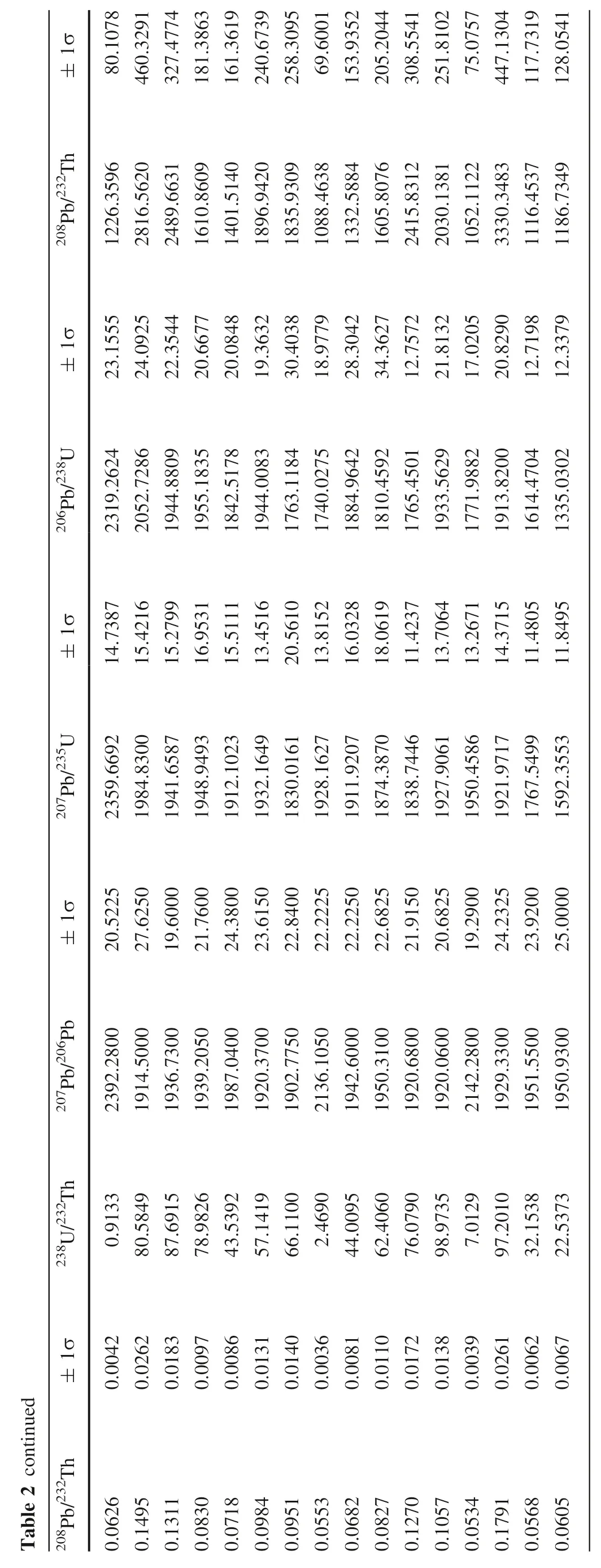
Similarly,the Hf isotope analysis was carried out on or adjacent to 10 zircon measuring points with concordant ages in Huozhou biotite plagioclase gneiss in the HX01 sample.The176Lu/177Hf ratios less than 0.002 indicate less radiogenic Hf accumulation of zircons after their formation.The176Hf/177Hf ratios of all measuring points range from 0.281437 to 0.281577,with an average of 0.281476(Table 6).However,the accumulation of radiogenic Hf is negligible after the formation of zircon which is evident from the considerably good homogeneity;hence the measured176Hf/177Hf ratio represents the Hf isotopic composition of the system during their formation.The overall variation of εHf(t) was in the range of -4.6-0.8,wherein the εHf(t) values were relatively concentrated,with an average of-3.3.The Hf model ages were calculated using their zircons’in-situ207Pb/206Pb ages.The main body falls within the average crustal evolution line between 3000 and 2500 Ma (Fig.15) with a TDM1(Ma) variation range of 2361~2496 Ma,average TDM1(Ma) of 2447 Ma,TDM2(Ma) variation range of 2613-2848 Ma,and average TDM2(Ma) of 2768 Ma.

Fig.15 Zircon εHf(t)values versus crystallization ages for gneiss in the Huozhou Complex
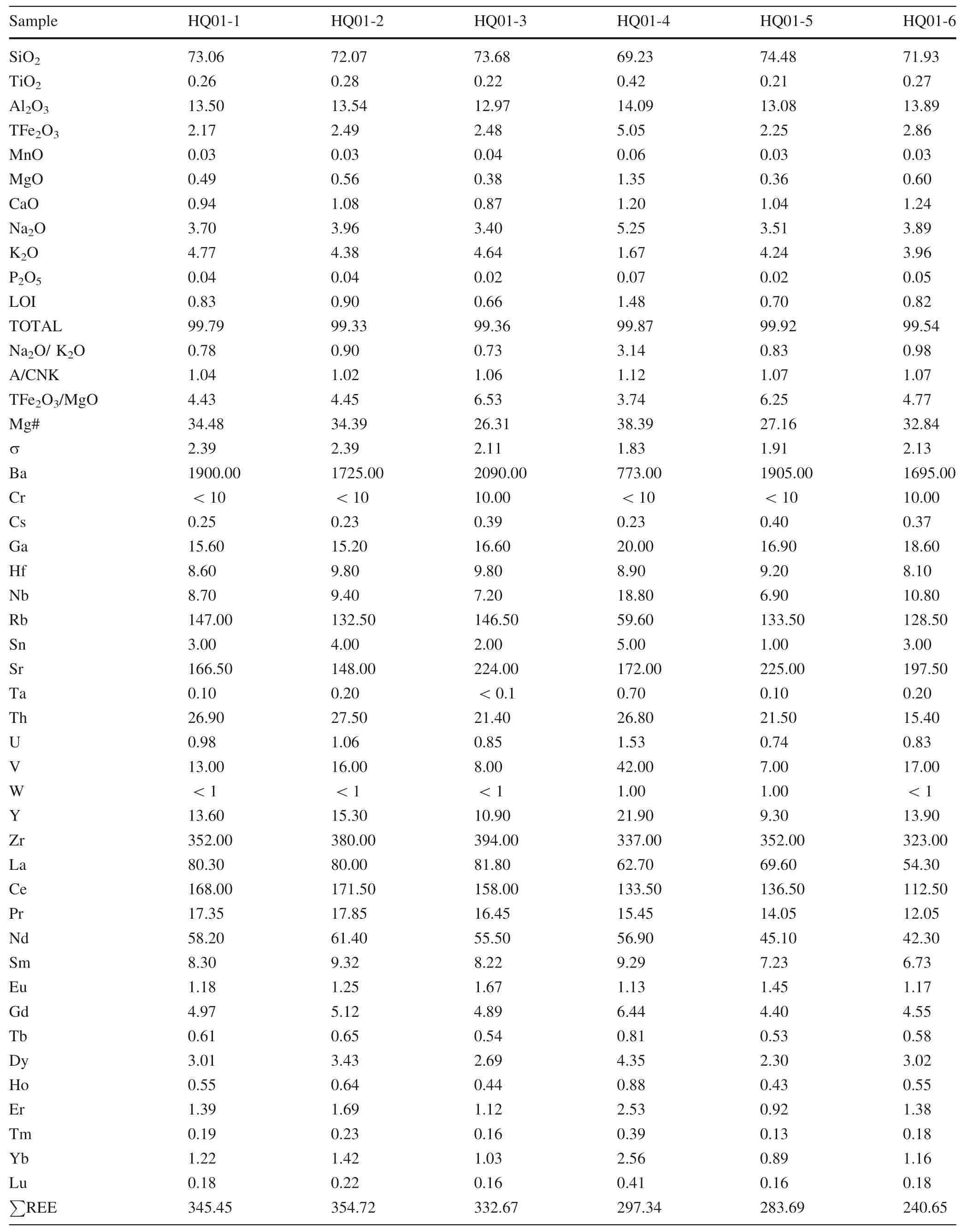
Table 3 The analytical results of major (%) and trace elements (ppm) of the Qinggangping gneiss (sample HQ01)

Table 3 continued

Table 4 The analytical results of major (%) and trace elements (ppm) of the Anziping gneiss (sample HX01)
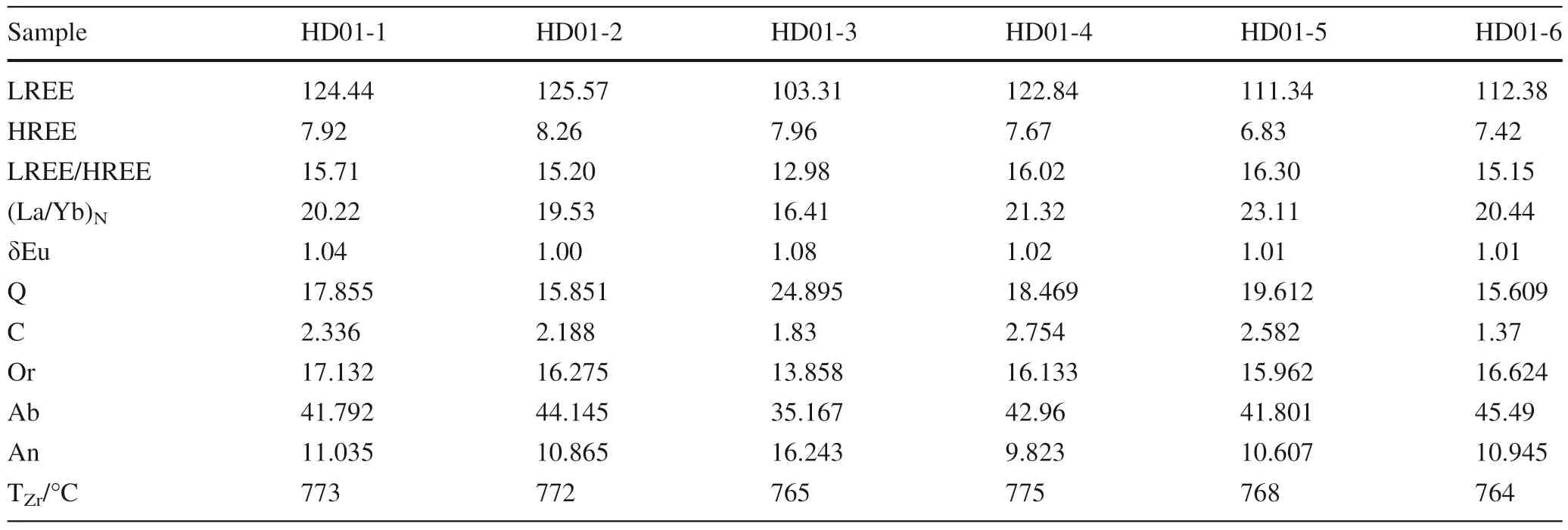
Table 4 continued
6 Discussion
6.1 Paleoproterozoic magmatic events and metamorphic events in the Huozhou area
Recent studies have reported the occurrences of several Archean-Paleoproterozoic magmatic metamorphic events(Fig.16) in the TNCO,under different stages which include (1) 2.8-2.7 Ga gneisses of relatively small extend and captured zircon concentrated mainly in the Xuanhua,Hengshan,Wutai and Fuping,Dengfeng and Taihua areas(Guan et al.2002;Kröner et al.2005);(2)~2.5 Ga TTG gneiss and granite gneiss concentrating in the granite greenstone belt in the Hengshan,Huai’an and Fuping complexes (Kröner et al.2005;Liu et al.2009) and the Wutai,Zhongtiao and Dengfeng complexes (Wilde et al.2005;Zhang et al.2013a,b;Deng et al.2016a);(3)2.4-2.3 Ga magmatic activity,including monzogranite in Chengde area,gaijiazhuang granite in Lüliang area and Yanzhuang granite in Zhongtiao area (Geng et al.2006;Zhao et al.2008a,b,2013,2015,2017;Zhou et al.2011;Zhang et al.2012);(4) 2.2-2.0 Ga magmatic activity concentrating in the Xuting granite of Zanhuang,metamorphic basalt of Gantaohe Group,dongshagou and lingyunkou monzogranite of Hengshan,Wangjiahui granite of Wutai area,potassic granite of Lushan area,shallow metamorphic basaltic andesite of Hutuo Group,and amphibolite of Jiangxian Group intercalated in Zhongtiaoshan area,the Nanying granitic gneiss in Fuping area,the Baiyuan tonalite gneiss in Taihua,the chijianling Guandishan gneissic granite in Lüliang,the meta basic volcanic rocks of the Lüliang Group and the metabasic volcanic rocks of the Yejishan Group (Wilde et al.2005;Du et al.2010;Zhao et al.2011,2013,2015,2017,2018;Zhou et al.2014);(5) 1.95-1.75 Ga magmatic activity,including huijiazhuang rock mass,Shizhuang rock mass,Luyashan rock mass,Hebei Pingshan anatexis pegmatite,perilla granite in Huai’an area,and Dapinggou garnet bearing S-type granite.Moreover,the Shiliang monzogranite,Motianzhai granite,Guijiayu granite,Shangdian granite porphyry,and Dengfeng syenogranite also occur in the southern margin of North China (Geng et al.2006;Zhao et al.2008a,b,2013,2015,2017).
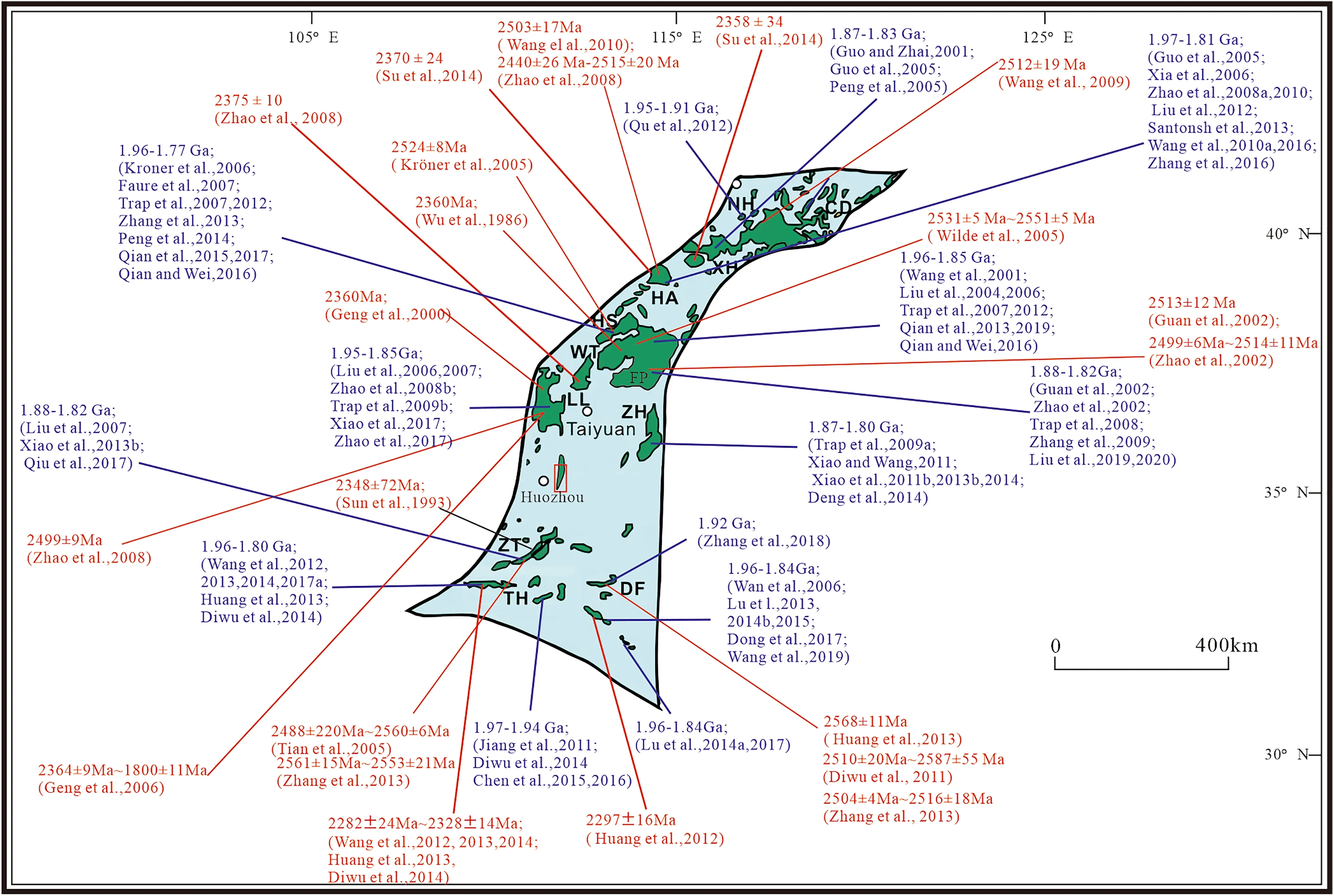
Fig.16 The spatial distribution of magmatic and metamorphic ages in the TNCO was revised by Duan et al.(2021)and Zhang et al.(2022).The red font in the figure represents the magmatic age,and the blue font represents the metamorphic age
Although most of the areas of TNCO have been thoroughly investigated,the Huozhou Complex is still in the early stages of the investigation.The age of formation of the Huozhou Complex is still uncertain,and its location is just on the axis of the TNCO,making it so significant.There is no detrital zircon with apparent transport features in the samples analyzed this time,neither metamorphic zircon HX01 nor magmatic zircon HQ01.Therefore,we conclude that these two samples are distinct from the surface crust series of the Jiehekou Group,which has been extensively studied in the TNCO.
The age of Qinggangping gneiss (sample HQ01) and Anziping gneiss (sample HX01) in the Huozhou area was determined in this study.The intersection age of the Qinggangping gneiss inconsistent line (sample HQ01) was determined to be 2196 ± 14 Ma.The zircons of the gneiss are hypidiomorphic to euhedral.Distinct magmatic oscillation bands characterize most zircons,and the Th/U ratio of most zircons is greater than 0.4.The protolith formation age is estimated to be 2196 ± 14 Ma.
Similarly,the intersection age of the inconsistent line is derived by the U-Pb dating of Anziping biotite plagioclase gneiss (sample HX01) as 1931 ± 13 Ma.Most of the zircons in this sample were characterized by Th/U <0.05,with metamorphic zircon characteristics,resulting in metamorphic age.In addition,the HX01 sample contains two magmatic zircon ages,which may represent the protolithic age of metamorphic rocks.This reveals that the Qinggangping biotite plagioclase gneiss in the north of the Huozhou Complex is Paleoproterozoic rather than Neoarchean and was formed during the magmatic event of~2196 ± 14 Ma,while the Anziping biotiteplagioclase gneiss in the south of the Huozhou Complex experienced a metamorphic event in~1931 ± 13 Ga.
6.2 Rock classification
According to existing research,granites are generally classified into M-type,I-type,S-type,and A-type.When the value of 10,000×Ga/Al is greater than 2.6,it may be A-type granite (Whalen et al.1987).The 10,000×Ga/Al value of only one sample of HQ01 is 2.68,while the remaining are 2.12-2.53.On the other hand,the 10,000×Ga/Al values of all the six rock samples of HX01 are 2.17-2.38,which are lower than the 10,000×Ga/Al critical value of 2.6 proposed by Whalen et al.(1987).In addition,HQ01 and HX01 do not have different representative alkaline dark minerals under the microscope,confirming a lack of A-type granitic features (Loiselle and Wones 1979;Whalen et al.1987).
Low K2O and Rb levels are the characteristic features of M-type granites.Sample HQ01 contains high concentrations of K2O (1.67% and 4.77%,average 3.94%) and Rb(59.60×10-6-147.00×10-6).Similarly,HX01 comprises high concentrations of K2O (2.28% and 2.80%,average 2.62%) and Rb (95.70×10-6-112.00×10-6).The two samples are distinguishable from M-type granite.
One of the most important parameters for distinguishing S-type granite from I-type granite is the aluminum saturation index.S-type granites are characterized by an aluminum saturation index(A/CNK)greater than 1.1 and high concentrations of SiO2.Moreover,these two types can be distinguished by their opposite expression of P2O5.The concentration of P2O5in I-type granite decreases with the increase in the concentration of SiO2.This negative correlation can be attributed to the different separation ratios between the metasedimentary rock source melt containing apatite crystal and the residual body containing apatite crystal.However,the concentration of P2O5in S-type granite increases with the increase in the concentration of SiO2.
The composition of corundum in CIPW is also an important indicator for distinguishing I-type granite from S-type granite.Corundum molecules less than one are typical of I-type granite,while corundum molecules greater than one are typical of S-type granite (Lu 2002).The magma temperature can also be used to differentiate I-type and S-type granites.I-Type granites are formed by remelting crustal igneous rocks at higher temperatures(White and Chappell 1977).S-type granites are formed by the remelting of crustal sedimentary rocks,and they have lower melting temperatures (Huang 2021;White and Chappell 1977).
The sample of Qinggangping biotite plagioclase gneiss(HQ01) in this paper belongs to I-type granite for the following reasons: (1) The P2O5concentrations of HQ01 samples decrease with the increase in concentrations of SiO2,with a distinct negative correlation,as shown in the relevant diagrams.This is produced by partially melting igneous rock without weathering and belongs to I-type granite(Fig.17).(2)Plagioclase,biotite,and quartz are the main mineral components of HQ01;without muscovite,this mineral association is consistent with the characteristics of I-type granite.(3)The sample HQ01 is high in light rare earth elements and large ion lithophile elements like Rb,Ba,u,and K,but low in heavy rare earth elements,which are typical of I-type granite(Ma et al.2018).(4)The CIPW standard mineral calculation results show that the majority of corundum molecules have values less than one(Table 3),which is typical of I-type granite.(5)The zircon saturation temperatures (TZr) of HQ01 indicate that the initial magma temperature is between 852 and 874 °C(Table 3),implying that it is remelting of igneous rocks.However,the initial magma temperature is a little higher than typical I-type granites and similar to A-type granites,which requires further analysis (Huang 2021).
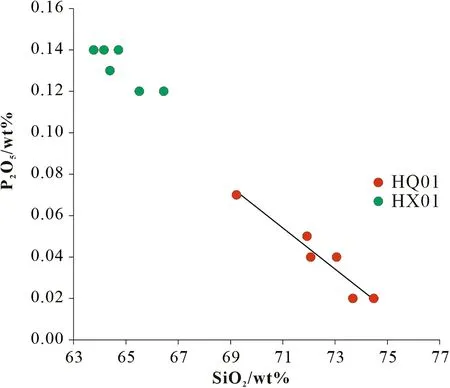
Fig.17 The P2O5-SiO2 diagram of gneiss in the Huozhou area
For the following reasons,the sample of Anziping biotite plagioclase gneiss (HX01) in this paper belongs to the S-type granite:(1)The major aluminum-rich mineral in the sample HX01 of Anziping gneiss under the microscope is garnet,with an A/CNK ratio greater than 1.1.The HX01-6 value is 1.06,indicating the sample HX01 should be S-type granite and also peraluminous granite(Fig.12c).The CaO/Na2O levels of S-type granites generated by partial melting in different homogeneous regions exhibit substantial variances in experimental petrological research.The CaO/Na2O ratio resulting from the remelting of argillaceous rocks is small,often less than 0.3,while that of sandy rocks is generally greater than 0.3.The S-type granites in the study area have CaO/Na2O values ranging from 0.43 to 0.83,all of which are greater than 0.3,indicating the formation of the source by partial melting of sandy rocks.(2)The CIPW standard mineral calculation results (Table 4)show that all the corundum molecules have values greater than one,which is typical of S-type granite.(3)The zircon saturation temperatures(TZr)of HX01 show that the initial magma temperature is between 764 and 773 °C (Table 4),indicating that it is the remelting of sedimentary rocks that conforms to the characteristics of S-type granite (Huang 2021).
6.3 Magma sources
The petrological and geochemical characteristics of the Qingyangping biotite plagioclase gneiss (sample HQ01)depict its evolution from medium to high potassium calcalkaline magma,with a slight Eu positive anomaly evidenced by a right dipping REE distribution curve.The large ion lithophiles (Rb,Ba) and high field strength elements (Th,Zr,Hf) are enriched,whereas Nb and Ti are depleted trace elements which results in the characteristics of melting products of shell-derived materials.Meanwhile,the zircon εHf(t) values range from 0.8 to 5.5,indicating that Hf isotopic composition is positive.The TDM1(Ma)varies in the range of 2346 -2521 Ma,with an average of 2452 Ma,and TDM2(Ma) varies in the range of 2431 -2719 Ma,with an average of 2604 Ma,indicating the origin of 2431-2719 Ma crustal material from the depleted mantle.The Mg index (Mg#) of sample HQ01 is less than 40 (Mg#=26.31-34.48),with a low Ti/Y ratio(10.9-21.9),indicating the uncertainty in the mantlederived materials.

The petrological and geochemical characteristics of the Anziping biotite plagioclase gneiss HX01 show its evolution from medium to high potassium calc-alkaline magmas,showing a slight Eu positive anomaly evidenced by a right dipping REE distribution curve.The large ion lithophiles(Rb,Ba) and high field strength elements (Th,Zr,Hf) are enriched,while Nb and Ti are depleted trace elements which results in the characteristics of the melting products of shell-derived materials.Except for one trace element,the εHf(t) values are all negative,as evidenced by the isotope Hf’s composition.All component points on the εHf(t)-tdiagram fall below the chondrite evolution line,with relatively concentrated εHf(t) values.The average TDM1(Ma) age is 2361-2496 Ma,and that of TDM2(Ma) is 2613-2848 Ma.When the fLu/Hfvalue is less than -0.72 for aluminosilicate crust and-0.34 for the ferromagnesian crust,the two-stage model age reflects the material separation era in the source during crust-mantle differentiation(Wu et al.2007).As the zircon fLu/Hfin this sample ranges from -0.96 to -1,the TDM2(Ma) is adopted in this study.The projection point of one sample falls between the evolution line of the depleted mantle and chondrite(εHf(t)>0) in the εHf(t)-tdiagram,while the remaining samples fall below the evolution line of chondrite;the variable εHf(t)values could indicate hybrid crustal sources(mafic-felsic).Even though the Mg#value of crust-derived magma is generally less than 40,it increases with the addition of mantle-derived materials (Richards and Kerrich,2007).The variation range of Mg index (Mg#) in the HX01 sample is 36.75-45.49,indicating the addition of mantle-derived materials into the source area.In conclusion,Anziping gneiss is primarily formed by transforming and recycling pre-existing crustal components at 2613-2848 Ma,with a small amount of mantle-derived magma added to the crust.

6.4 The tectonic setting of~2.2 Ga magmatic activity
Although several scholars have worked on the TNCO,there are still many disagreements about the~2.2 Ga old tectonic system with no ultimate consensus until now.The two major opposing viewpoints are as follows:
(1) Some researchers believe that the TNCO of~2.2 Ga is a continental rift zone,based on the‘‘bimodal’’volcanic rock association of basic volcanic rocks of Lüliang Group and Dujiagou rhyolite,and that composed of metamorphic basalts of Gantaohe Group and Xuting potassium-rich granite.Some of the other studies have reported 2.2-2.0 Ga A-type/potassic granites,including Xuting granite in the Zanhuang area at~2090 Ma (Yang et al.2011),Lingyunkou granite in the Hengshan area at~2080 Ma (Zhao et al.2011),Huangjinshan granite in Wutai Area at~2137 Ma,Wangjiahui (pink facies) granite at~2120 Ma,and Dawaliang granite at~2170 Ma (Wilde et al.2005;Du et al.2013).Some researchers proposed that the 2.2-2.0 Ga magmatism along the TNCO exhibits two stages of 2.2-2.1 Ga and 2.1-2.0 Ga in different regions,some granites in the 2.2-2.1 Ga stage show the features of A-type granite and form the bimodal magmatic assemblages with the coeval mafic rocks(Du et al.2018).
(2) The TNCO has been located in an active continental margin arc environment during this period,based on the findings of some researchers.According to Wang et al.(2010a,b),the 2193 ± 15 Ma Yanmenguan mafic-ultramafic intrusive body in the Wutai area has the magmatic characteristics of an Alaska-type intrusive body and subduction zone or arc with the characteristic features of a continental margin arc.Liu et al.(2014a) identified a set of ‘‘adakite-high magnesium andesite-rich Nb basalt-andesite’’assemblage of 2200 Ma age in the Yejishan Group in the Lüliang area,representing a typical island arc magmatic assemblage related to oceanic slab subduction.According to Zhao et al.(2017),the~2.2 Ga meta basic volcanic rocks of Zhouying formation of the Lüliang Group in the Lüliang area were formed in an active continental margin arc environment.However,the acidic end members of bimodal volcanoes reported by the predecessors were questioned by Du et al.(2012),who claimed that these might not be rhyolites,such as feldspar porphyry in Dujiagou.
There are several reports in the TNCO regarding the 2.2-2.0 Ga granitoids with typical geochemical and isotopic characteristics of island arc granitoids formed in a subduction-related arc environment.These rocks are derived from a mantle source under the continent that has been enhanced to variable degrees by continental crust or subduction components(Liu et al.2009;Zhao et al.2008a;Santosh et al.2015).This paper reports the magmatic ages of the Qinggangping gneiss(sample HQ01)at 2196 ± 14 Ma and two magmatic ages of Anziping gneisses (sample HX01) at~2.3 Ga(2392 ± 21 and 2302 ± 31 Ma).In the spider diagram of primitive mantle standardization,Qinggangping gneiss and Anziping gneiss exhibit distinct negative characteristics of Nb,Ti and P elements,indicating the correlation of rock characteristics with magmatic rocks in the island arc or subduction environment.Meanwhile,the samples fall within the volcanic arc granite area in the discrimination diagram of the granite trace element environment (Fig.18).It is hypothesized that a major magmatic intrusion event occurred in the Huozhou area at 2196 ± 14 Ma,possibly formed in the tectonic environment of the continental margin arc,based on the petrochemical characteristics,zircon U-Pb chronology,and Hf isotope data reported in this paper.Although the Anziping gneiss has limited magmatic age information,the number is insufficient to determine its magmatic age.Also,the prediction of the environment of continental margin arc at 2.3 Ga is impossible,even though the determination of specific magmatic age is essential.Finally,based on the genetic characteristics of previous basic volcanic rocks and the granitism in island arcs during the same period,at~2.2 Ga,the central part of the NCC may be in an active continental margin arc environment,according to this study.Apart from the intrusive rocks associated with the arc in the Huozhou Complex,numerous igneous rocks produced in a subducted setting have been vigorously recorded from north to south along the TNCO since~2.2 Ga,such as the intermediate acid intrusive rocks of 2189-2153 Ma in the Lüliang Complex,2170 Ma opx-bearing monzonitic gneisses in the boundary zone between the Jining and Huai’an Complexes,2036 Ma Dongjiagou granitic gneiss in the Huai’an Complex,2248 Ma Xiaoshiyu pegmatite and 2113 Ma anatectic granite in the Hengshan Complex,2045 Ma Nanying granitoid gneisses in the Fuping Complex and 2164 Ma Bayuan tonalite gneiss and 2170 Ma Muce monzonitic gneisses in the Taihua Complex(Chen et al.2016;Du et al.2012;Guan et al.2002;Huang et al.2013;Liu et al.2009;Santosh et al.2015;Trap et al.2009;Wang et al.2015;Zhao et al.2008a,b,2020).Strong arc magmatism in an active continental arc setting occurred around~2.2 Ga along TNCO.

Fig.18 The discrimination diagram of trace element environment of gneisses in the Huozhou area(Pearce et al.1984).The abbreviations ORG,VAG,WPG,and COLG,represent oceanic ridge granites,volcanic arc granites,within-plate granites,and COLG granites,respectively
Furthermore,Wang et al.(2022a,b) concluded from a thorough geochemical study of the magmatic rocks in the Huozhou area that the 2.2-2.1 Ga diorites,mafic-ultramafic cumulates,and regional mafic dykes/intrusions all descended from the same suite of continental arc magmas.The low18O signatures in the 2.3 Ga and 2.18 Ga granites suggest that the southern part of the TNCO transitioned from a lithospheric rift to an active continental margin between 2.3 and 2.1 Ga.
7 Conclusions
(1) The present study reported a 2.2 Ga magmatic event and a 1.93 Ga metamorphic event.
(2) Qinggangping gneiss is an I-type,and its native rock is thought to be juvenile crust material formed by a depleted mantle at 2431-2719 Ma,while Anziping gneiss is an S-type granite formed by the transformation and recycling of pre-existing crustal components of 2613-2848 Ma.And a small amount of mantle-derived magma is added to the crust
(3) At 2.2 Ga,the Huozhou region in TNCO may have been in an active continental margin arc environment,and at 1.9 Ga,it underwent a metamorphic event.
Supplementary InformationThe online version contains supplementary material available at https://doi.org/10.1007/s11631-022-00570-x.
AcknowledgementsThis research was jointly supported by the open fund from the Key Laboratory of Deep-Earth Dynamics of Ministry of Natural Resources,Institute of Geology,Chinese Academy of Geological Sciences (Number J1901-16);the project of graduate education and teaching reform in Shanxi Province (Award Number 2021YJJG147);the teaching reform project ‘Geographic Modeling,Simulation and Visualization’’ established by Shanxi Normal University(Number 2019JGXM-39);‘‘The Research Start-up Fund of Shanxi Normal University for Dr.Peng Chong in 2016’’ (Number 0505/02070438);‘‘The Research Start-up Fund of Shanxi Normal University for Dr.Liu Haiyan in 2017’’ (Number 0505/02070458);and ‘The Research Fund for Outstanding Doctor in 2017’’ (Number 0503/02010168),established by the Education Department of Shanxi Province for Dr.Liu Haiyan.
Authors’ contributionsCP and BP conceived and designed the experiments;HL directed the writing of this article.HL perfected English writing and contributed analysis tools;CP,HL and LX analyzed the data and wrote the paper.All authors read and approved the final manuscript.
Declarations
Conflict of interestOn behalf of all authors,the corresponding author states that there is no conflict of interest.The authors declare that they have no competing interest.
杂志排行
Acta Geochimica的其它文章
- The discovery of TiO2-II,the α-PbO2-structured high-pressure polymorph of rutile,in the Suizhou L6 chondrite
- Geochemical studies of hybrid granite from Madugulapalli area,Eastern Dharwar Craton,Southern India: Implications for crustal mixing
- How to estimate isotope fractionations of a Rayleigh-like but diffusion-limited disequilibrium process?
- Source rock potential assessment of the Huai Hin Lat Formation,Sap Phlu Basin,Nakhon Ratchasima Province,northeastern Thailand
- Distribution and geochemical significance of trace elements in kerogens from Ediacaran-Lower Cambrian strata in South China
- Fate and toxicity of nanoparticles in aquatic systems
